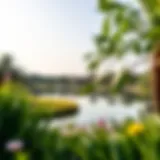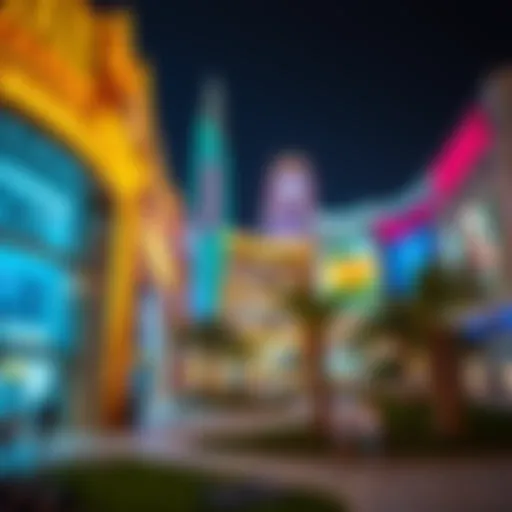Exploring Masdar City: A Model for Sustainable Urban Living
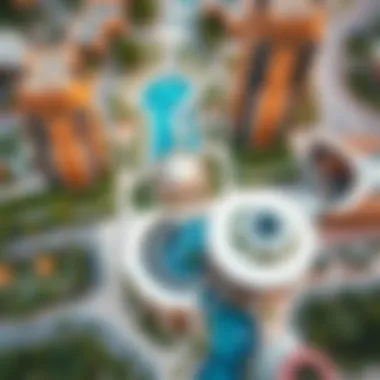

Intro
Masdar City, nestled in the heart of Abu Dhabi, stands as a striking example of what the future of urban living might become. Developed by the Abu Dhabi Future Energy Company, it aims to blend cutting-edge technology with sustainable living practices. In this city, every brick and beam serves a greater purpose, reflecting innovative designs aimed at addressing some of today’s most pressing environmental challenges. The ambition behind Masdar City isn't just to create a habitat; it's to establish a living laboratory for advancements in sustainability, showcasing what can be done in urban environments everywhere.
While the vision is grand, it is equally important to ground these lofty ideas in reality. The objectives established during its inception involve more than just aesthetics; they integrate rigorous environmental strategies and state-of-the-art technological advancements. This article takes a detailed look at Masdar City, examining its origins, design principles, market trends, lifestyle insights, and the challenges it encounters.
Through this exploration, it will become clear how Masdar City serves as not only an aspirational model but also as a practical blueprint for future urban developments. For investors, realtors, and eco-conscious homeowners alike, understanding this groundbreaking city can provide insights into emerging market trends and the evolving landscape of ecological living.
Preface to Masdar City
Masdar City stands as a beacon of innovation in sustainable urban development, for those keen to grasp the future of eco-friendly living. This pioneering city, situated just outside of Abu Dhabi, is not just another urban project; it’s a vision molded by necessity and ambition. As the world grapples with the consequences of rapid industrialization and climate change, Masdar City embodies a proactive approach towards energy efficiency and sustainability. Here, one can find a convergence of cutting-edge technology with thoughtful urban planning, making it a compelling case study for investors, developers, and anyone curious about sustainable lifestyles.
The significance of Masdar goes beyond its architectural beauty and innovative systems. It emphasizes the need to balance comfort and convenience with ecological responsibility, encouraging a shift in how we conceptualize urban living.
Historical Context
Masdar City’s roots can be traced back to 2006, when it was first announced by the Abu Dhabi Future Energy Company. The establishment of this city was a response to the pressing issues of oil dependency and the need for a diversified economy. At its inception, Masdar was envisioned as a hub for clean tech and renewable energy, aiming to become the first zero-carbon city globally.
Over the years, it has faced its fair share of ups and downs. Constructing a sustainable city from scratch is no small feat, and the project has evolved according to both successes and setbacks. Today, Masdar City is still under development, gradually turning the aspirational goals into tangible realities.
Significance of Sustainable Development
Sustainable development in Masdar City shines in various forms, contributing to an enlightening narrative about urban living. First off, the city opts for advanced renewable energy solutions, harnessing solar energy as a critical element of its infrastructure. With solar panels, for instance, positioned on rooftops and unused land, Masdar leverages the abundant sunlight of the region efficiently.
Furthermore, sustainability in Masdar extends into its urban design. The layout promotes walkability, reducing reliance on vehicles, which helps minimize carbon emissions. The integration of green spaces, parks, and shaded walkways enhances not only the environmental aspect but also the quality of life for residents and visitors.
The significance also lies in the knowledge-sharing aspect; Masdar serves as a laboratory for sustainable practices, attracting researchers, academics, and environmentalists from all over the globe. This hub of learning and innovation often leads to new ideas and approaches that could transcend geographical boundaries.
"Masdar City encapsulates the future of urban living, harmonizing innovation with the ecological principles necessary for our survival."
Design and Planning Principles
The principles behind the design and planning of Masdar City stand as a testament to innovative urban development. Here, it’s not just about building structures; it's about creating an eco-conscious lifestyle that integrates seamlessly with nature. This planning approach sets the stage for sustainable living while addressing the pressing issues of climate change and urbanization. Key considerations include energy efficiency, human scale design, and community engagement, all geared towards establishing a low-impact urban framework.
Urban Structure
The layout of Masdar City reflects a deep understanding of how urban environments function. At its core, Masdar is designed to encourage walking and cycling, reducing dependence on motor vehicles. The compact structure not only minimizes land use but also promotes a vibrant community atmosphere.
- Narrow streets and shaded walkways foster an environment where people feel safe and comfortable to navigate on foot.
- Mix-used spaces combine residential, commercial, and recreational areas, ensuring that every essential service is within reach.
- The use of traditional Arabic architectural elements also helps to regulate temperatures, blending efficiency with aesthetic appeal.
This urban structure effectively champions the idea that great cities can thrive without sacrificing sustainability.
Architectural Features
Architectural elements in Masdar City are designed to have minimal environmental impact while providing maximum comfort and utility to its inhabitants. Key features worth highlighting include:
Low Carbon Footprint
A low carbon footprint is not merely an architectural choice; it’s a fundamental philosophy guiding the development of Masdar City. By using cutting-edge technology and innovative design principles, buildings are constructed with the intent of consuming less energy and producing fewer emissions.
- Key characteristics such as strategically placed windows and thermal mass allow buildings to maintain comfortable temperatures naturally, reducing reliance on air conditioning.
- A notable feature of this approach is the integration of solar panels on rooftops, harvesting renewable energy and promoting self-sufficiency.
- While the initial buildup costs might be steeper than traditional development, the long-term savings in energy and maintenance present a compelling argument for investors focused on sustainability.
Sustainable Materials
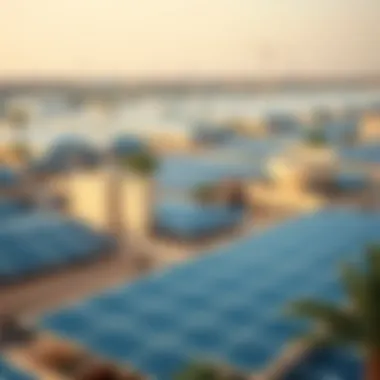
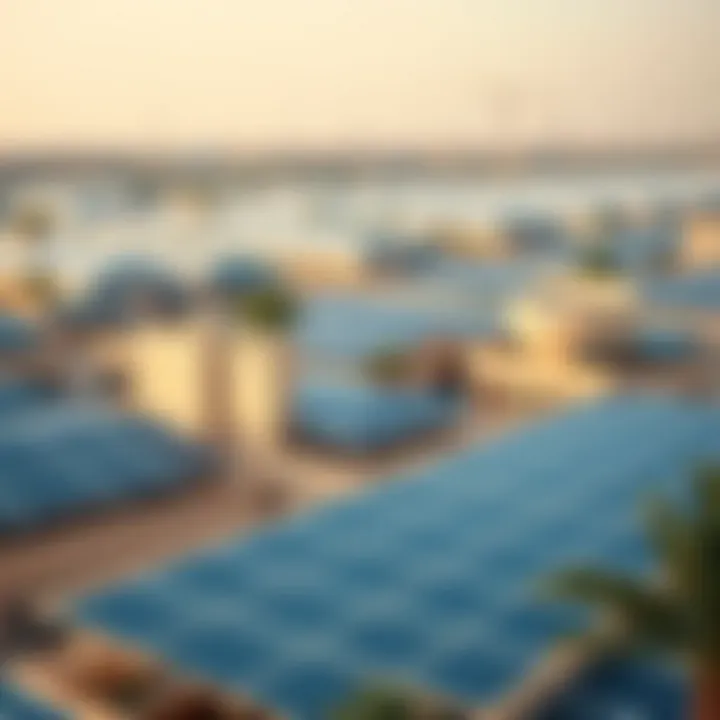
The selection of materials plays a critical role in the overarching goals of Masdar City. The commitment to sustainability is evident in the careful choice of construction materials aimed at reducing ecological impact.
- One of the main characteristics of sustainable materials is their minimal environmental footprint; they are sourced from low-impact or recycled sources.
- Unique features like locally sourced materials not only cut down on transportation emissions but also provide economic support to local suppliers.
- Though challenges such as availability and cost fluctuations exist, the investment in sustainable materials is proving to be a wise choice for long-term viability.
Green Spaces
Green spaces in Masdar City are essential for enhancing the quality of life of its residents. These areas, which combine parks, gardens, and artificially created wetlands, are meticulously planned to support biodiversity while also serving as social hubs for communal activities.
- Benefits include:
- Improved air quality through the natural filtration capabilities of plants.
- A reduction in urban heat, creating cooler microclimates within the city.
- Spaces designed for relaxation, recreation, and social interaction, vital for community cohesion.
In summary, the design and planning principles of Masdar City underline the importance of sustainable urbanization, illustrating a clear vision for future developments. As we delve deeper into Masdar, the persistent commitment to marrying ecological sensibilities with living space becomes abundantly clear, ensuring that it stands as a beacon for other cities seeking sustainable solutions.
Environmental Strategies
The environmental strategies implemented in Masdar City are central to its vision of being a paragon of sustainability. These strategies serve not only to reduce the city's ecological footprint but also to create a livable, functional space that integrates environmental consciousness into everyday living. By prioritizing renewable energy, efficient water use, and innovative waste management systems, Masdar City illustrates how urban areas can harmonize with nature while addressing the pressing challenges of climate change and resource depletion.
Renewable Energy Initiatives
Masdar City's commitment to renewable energy is particularly noteworthy. The city aims to operate on 100% renewable energy, predominantly harnessed through solar power. Solar panels blanket various structures, absorbing the rich sunlight typical of the region. The Masdar Solar Plant, located just outside the city, has become a symbol of the potential for solar energy in arid environments.
In pursuit of energy efficiency, Masdar City also employs innovative solutions, such as energy production from waste. The integration of clean energy technologies showcases a model that other urban developments can follow. The shift from traditional fossil fuels to renewable sources not only curtails pollution but brings financial benefits in the long term through decreased energy costs.
Water Conservation Techniques
In arid regions, water is more precious than gold. Masdar City has recognized this truth and established robust water conservation techniques. Key initiatives include the use of greywater recycling systems, which treat and repurpose wastewater for landscaping and irrigation. This method not only preserves freshwater resources but also ensures that green spaces flourish despite the naturally dry climate.
Furthermore, the city employs advanced irrigation techniques, like drip irrigation, to deliver water directly to plant roots. This minimizes evaporation and runoff, maximizing efficiency. Incorporating native plant species into landscaping further enhances water conservation efforts, as these plants are adapted to the local climate and require less irrigation.
Waste Management Systems
Effective waste management is another cornerstone of Masdar City's environmental blueprint. The city implements a zero-waste philosophy, which means that all waste generated is either recycled, composted, or reused. The waste management system operates using cutting-edge technology that sorts materials efficiently, ensuring that nothing goes to a landfill unnecessarily.
Residents are encouraged to participate actively in the waste management process through educational programs that promote recycling and composting. This collective effort enhances community engagement while fostering a strong sense of responsibility towards the environment. The ultimate goal is to create a circular economy within Masdar City, where materials are kept in use for as long as possible, thereby minimizing waste and resource extraction.
“In Masdar City, we are not just planning for the future; we are creating it.” - This quote encapsulates the essence of environmental strategies implemented here.
Through these comprehensive environmental strategies, Masdar City not only addresses the urgent issues of sustainability but also sets a tangible example for urban planners, investors, and policymakers around the globe. As the world grapples with environmental challenges, cities like Masdar can demonstrate the path forward, balancing urban life with ecological integrity.
For further information about sustainable living practices and urban planning, visit Wikipedia and Britannica for insightful articles.
Technological Innovations
When one considers the future of urban living, technological innovations stand as a cornerstone of intelligent design. Masdar City, with its cutting-edge approach to urban development, serves not just as a living community but as a testing ground for innovations that aim to redefine our relationship with the environment. These technologies play an integral role in energy efficiency, transportation, and overall quality of life. Their importance in Masdar City cannot be overstated, as they provide systematic solutions that cater to sustainability while enhancing the residents' everyday experiences.
Smart Grid and Energy Management
At the heart of Masdar City's infrastructure is the smart grid technology. This system connects various energy sources efficiently, allowing for the optimization of electricity distribution. The smart grid is not just a high-tech buzzword; it is a fundamental feature that helps manage energy consumption smarter and encourages renewable energy use.
Moreover, it integrates vast amounts of data generated by homes and buildings, helping to monitor and adjust energy usage in real time. This means that residents can not only track their consumption but also reduce costs, thereby contributing to a larger goal of sustainability. Given that the city operates on a mix of solar and other renewable energies, the smart grid essentially functions as a brain, ensuring these resources are utilized at their fullest potential.
"The advanced energy management systems explored in Masdar City set a benchmark for future urban developments globally."


Transportation Solutions
The transportation paradigm in Masdar City embodies the essence of sustainability through various initiatives designed to reduce traditional vehicle emissions. The advancements range from electric vehicle infrastructures to efficient public transport systems that ensure mobility without compromising the environment.
Electric Vehicle Infrastructure
Masdar City showcases an electric vehicle infrastructure that plays a pivotal role in reducing carbon footprints. By offering sufficient charging stations and promoting electric vehicles, this infrastructure significantly lowers emissions associated with travel. It is designed with user convenience in mind. For instance, most charging points are strategically situated within easy reach of major zones in the city, allowing for quick refueling of vehicles.
A unique feature of this infrastructure is its integration with a smart grid, which enhances energy efficiency. charging stations operate with energy sourced from renewables, ensuring that the power fueling these vehicles is just as clean as the vehicles themselves. However, a challenge remains. The upfront cost of electric vehicles can deter potential users, making awareness and incentives essential to enhance adoption rates.
Public Transportation Systems
Public transportation in Masdar City is designed to be not just effective but also sustainable. Powered by renewable energy, the public transportation systems offer a green alternative to conventional transit options. Highlights include electric buses and solar-powered light rail systems, which are not only efficient but also significantly cut down on greenhouse gas emissions.
One standout aspect of these public transit solutions is the integration with lifestyle choices; they are often linked with walking and cycling pathways that connect various neighbourhoods. However, despite these benefits, the implementation faced challenges such as ensuring frequency and accessibility at all times to accommodate the diverse schedules of residents. Furthermore, public awareness of the benefits of using these systems plays a vital role in their success.
Social Aspects of Living in Masdar City
Understanding the social fabric of Masdar City is vital to grasp what makes this project pioneering. The blend of innovative design and community well-being is not only a fundamental aim but also a critical indicator of its long-term success. At its core, Masdar City seeks to create a lifestyle where sustainability is ingrained in everyday living. The symbiotic relationship between the community, lifestyle nuances, and educational opportunities shapes the way residents engage with their environment.
Community and Lifestyle
Life in Masdar City offers a unique experience characterized by a strong sense of community. The planned urban layout promotes interaction among residents. Walkable pathways discourage reliance on cars, enhancing not just health through increased physical activity but also fostering relationships as neighbors often bump into each other while going about their daily routines. Community events play a crucial role. From farmers’ markets to cultural festivals, these gatherings cultivate shared experiences that help bond residents.
Moreover, greenery is integrated within the architecture. Many homes and public spaces feature gardens and landscaping that encourage outdoor activities. This accessibility to nature not only enhances residents' well-being but also cultivates an appreciation for ecological preservation. The reservoirs of plants and trees act as lungs for the city, creating a refreshingly clean environment while providing social spaces for relaxation and gatherings.
In terms of amenities, Masdar City is richly prepared. Grocery stores, cafes, and recreational facilities are designed with sustainability in mind. For example, a local shop selling organic produce is not just a business; it’s a place where residents develop relationships, support local artisans, and engage with one another. Here, consumers are not just buying products, they’re investing in their community.
Educational and Research Opportunities
Education is another facet that distinguishes Masdar City. Hosting institutions like the Masdar Institute, it becomes a hotspot for research and innovation focusing on sustainable development. This institute collaborates with reputed entities, offering exclusive programs that delve into renewable energy and environmental sciences. Such academic opportunities attract not only local but also international scholars and students, fostering a culturally diverse atmosphere with intellectual excitement.
The city also emphasizes lifelong learning. Residents have access to workshops, public lectures, and seminars that engage them on sustainability practices and technological advancements. For investors and developers, this educational component can be a significant draw. A well-educated populace is more likely to drive innovation while appreciating and supporting sustainable practices.
Prospective residents can benefit greatly from these offerings, knowing that they are part of a living laboratory for sustainable technologies. This kind of environment could be argued to be invaluable for families, ensuring that future generations inherit the knowledge to sustain the city's ecological ethos.
"A community that learns together, lives together – a fundamental tenet of life in Masdar City."
For more insights, visit Masdar City or check resources from Wikipedia and Britannica.
Challenges and Critiques
As with any ambitious project, Masdar City faces its fair share of challenges and critiques. Understanding these nuances is crucial for investors, developers, and potential residents alike and reflects the realities of pushing the boundaries in sustainable urban planning.
Economic Viability
One of the prominent concerns surrounding Masdar City is its economic viability. The initial investment in this eco-city was substantial, and the long-term profitability is still under scrutiny. Skeptics question whether the heavy expenditure invested in infrastructure will eventually yield enough returns to justify itself.
Several factors contribute to the economic aspect. For one, the allure of sustainability draws interest from eco-conscious investors. However, balancing eco-initiatives with profitable business ventures remains a tightrope walk.
The cost of technology and adopting sustainable practices can enhance operational expenses. Here are key points to consider:
- High initial costs of renewable energy installations
- Potential financial risk if technology fails to deliver as expected
- Competitive market with other urban developments offering lower costs
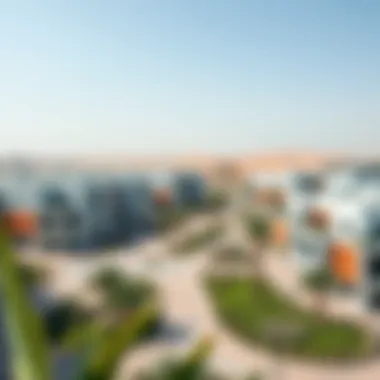
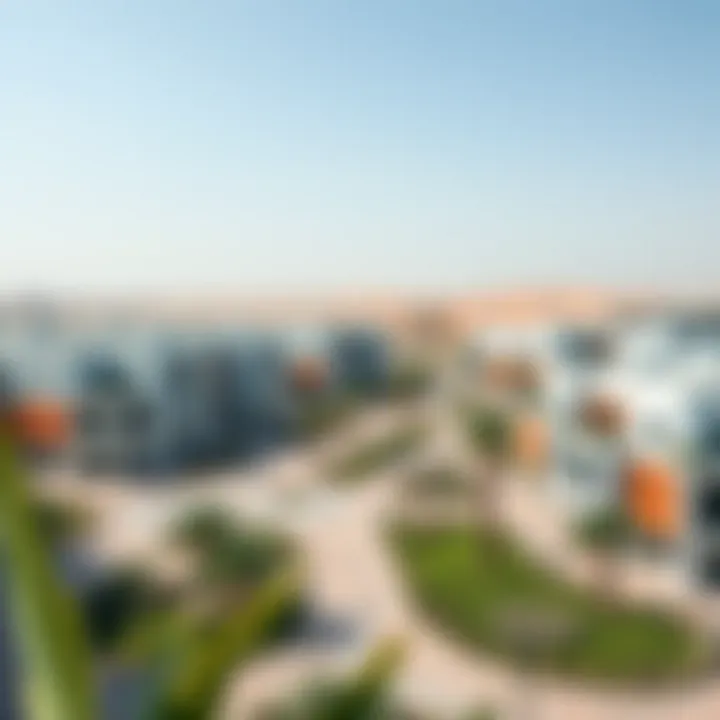
But it's not all doom and gloom. Some report that Masdar City has attracted a series of startups focused on renewable energy and sustainable living, suggesting a shift toward a potential ecosystem of green innovation. Overall, the financial landscape remains dynamic, impacted by both local policy changes and global market trends.
Real Estate Development Concerns
Real estate development in Masdar City has also been a matter of concern. The ambitious plans for housing and commercial spaces have faced hurdles, including economic conditions and the pace of development. Many investors have reservations about whether there will be enough demand for properties in a city that prides itself on sustainability.
A few notable issues include:
- Limited market comparisons: Few cities offer a sustainable lifestyle in a similar manner, lacking the blueprint for what successful uptake looks like.
- Development delays: Progress has often been slower than anticipated, which can deter potential buyers or investors waiting for a completed product.
- Public perception: Many view Masdar City as a high-concept project that may seem distant or impractical to everyday life, which can impact sales and investment.
Despite these hurdles, there is community interest in green living and sustainability. Developers continue to focus on creating quality living spaces that incorporate modern design and sustainable materials. Future success may hinge on addressing the concerns of accessibility, functionality, and adapting to the demand for eco-friendly housing and workplaces.
"In the world of real estate, perception is key; investors must believe in the vision for Masdar City before committing their funds."
In light of these challenges, the status of Masdar City remains a topic of conversation in property and environmental circles. Navigating economic viability and real estate development concerns will require strategic planning and voice from a knowledgeable community.
For further reading:
- Wikipedia on Masdar City
- Sustainable Development Resources from the United Nations
- Economics of Sustainable Cities at Britannica
Future Outlook
The future of Masdar City looms large in discussions of sustainable urban development. As a groundbreaking initiative in Abu Dhabi, its relevance goes beyond local borders, positioning it as a model for cities worldwide. Understanding future prospects here involves several elements, including ongoing expansion efforts, technological advancements, and lessons learned from its journey thus far. These factors create a unique blueprint for other urban areas aiming for sustainability while tackling the pressing issues of climate change and resource management.
Expansion Plans
Masdar City is not resting on its laurels. Expansion plans are an integral part of its trajectory, aimed at incorporating more residential and commercial spaces within its sustainable framework. The intention is to draw in businesses and attract residents who appreciate eco-friendly living. A noteworthy aspect of these plans is the anticipated introduction of more green buildings, which will comply with the stringent sustainability standards that Masdar promotes.
In recent discussions, stakeholders outlined potential regions within the city that would benefit from additional development. Spanning both residential and business districts, this growth is aimed at fostering a vibrant community with a blend of work and leisure spaces. Moreover, initiatives to enhance public facilities, parks, and recreational areas are on the table, ensuring a balanced lifestyle for all inhabitants.
"Building sustainably today yields the dividends of a healthier planet tomorrow."
This approach underscores the holistic vision of Masdar. By creating a diverse yet cohesive urban environment, the city stands to become a hub for innovation and environmental stewardship.
Potential Impact on Global Urban Planning
Masdar City's vision extends beyond its locale. The lessons derived from its establishment and growth could reshape urban planning in significant ways. For instance, its emphasis on renewable energy and smart technology creates a model that other cities could potentially emulate.
With the world facing unprecedented environmental challenges, this city offers a tangible illustration of how integrating tech and nature can yield successful results. Thought leaders and urban planners may take inspiration from Masdar's practices, adopting elements such as its waste management systems and energy conservation methods in other contexts.
Some key takeaways include:
- The need for collaboration between private and public sectors to ensure both viability and innovation.
- The importance of community engagement in urban design and development efforts.
- Strategies for blending modern technology with traditional living practices to promote sustainability.
Ending
The conclusion of this exploration into Masdar City serves as a pivotal point for understanding its role in the broader narrative of sustainability and urban innovation. Masdar City illuminates the pathways toward sustainable living, presenting tangible examples of how modern urban centers can reconcile the demands of growth with the imperative of environmental stewardship. It holds a mirror to our current urban practices, urging us to rethink how cities should function under the pressures of climate change and resource depletion.
One significant element of Masdar City's framework is its commitment to renewable energy. Nearly every building and infrastructure piece is designed to harness alternative energy sources, markedly reducing dependence on fossil fuels. This not only curtails emissions but is also a clear signal to investors and developers of the lucrative potential tied to sustainable energy solutions. The economic viability of such projects is bolstered by growing global interest in green technologies, providing a marketplace ripe for innovative ventures.
Further, the integration of smart technologies sets Masdar City apart as a blueprint for futuristic urban planning. By incorporating advanced technologies, such as smart grids and electric vehicle infrastructure, it enhances functionality while optimizing energy use. This is particularly appealing for investors, as technological integration often leads to increased property value and tends to attract a demographic that values sustainability.
Importantly, Masdar City also emphasizes the value of community and lifestyle, showing that sustainability is not merely a technical endeavor but a holistic one. Offering knowledge sharing opportunities, events, and communal spaces, it allows residents and visitors to engage with a lifestyle that's in sync with ecological principles. This community aspect draws in renters and homeowners who are increasingly looking for integrative living environments.
In summary, Masdar City stands as an exemplary model for sustainable development, showcasing how innovative design, technological advancements, and community engagement can shape future urban landscapes. It invites investors, realtors, and homeowners alike to not only witness but participate in a movement towards a more sustainable future. Bolstered by its successes and the lessons learned from its challenges, Masdar City's influence may very well extend beyond its borders, offering insights into how cities worldwide can adapt for a sustainable tomorrow.
"Sustainability isn't just a trend; it's the foundation for future viability in urban landscapes."
As the world navigates through the complexities of modernization and environmental demands, taking cues from Masdar City can lead to innovative approaches across urban planning and development.




